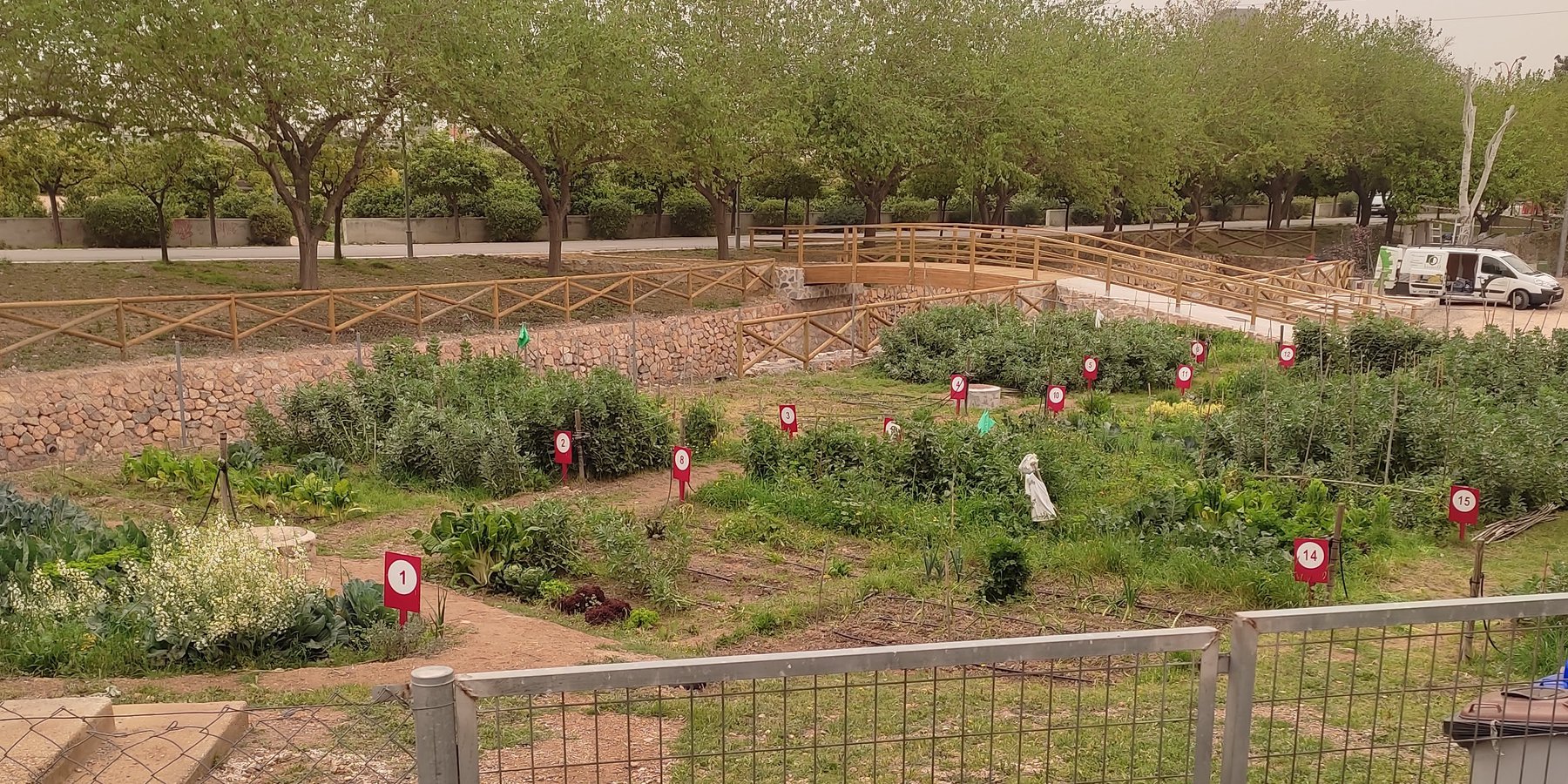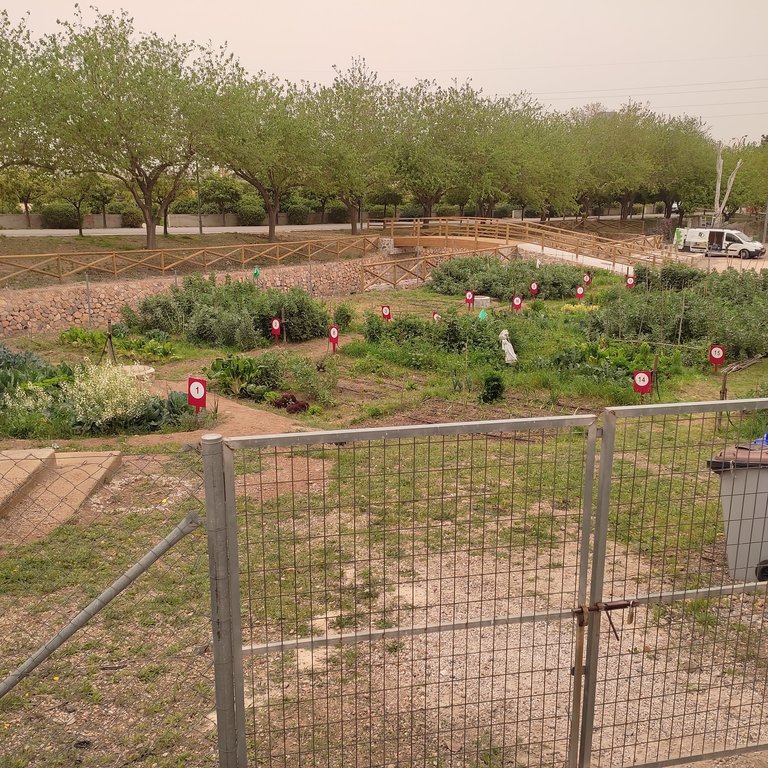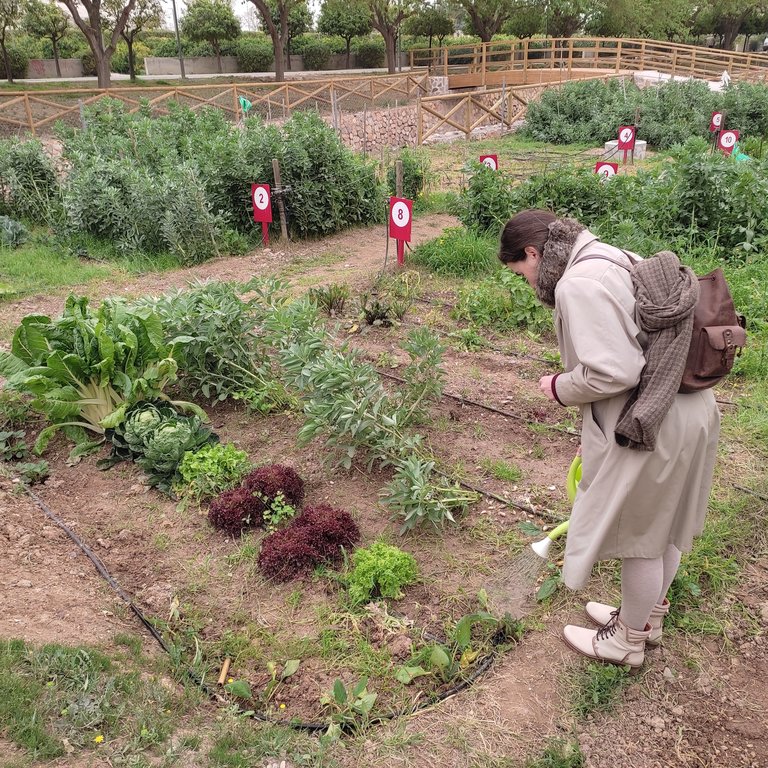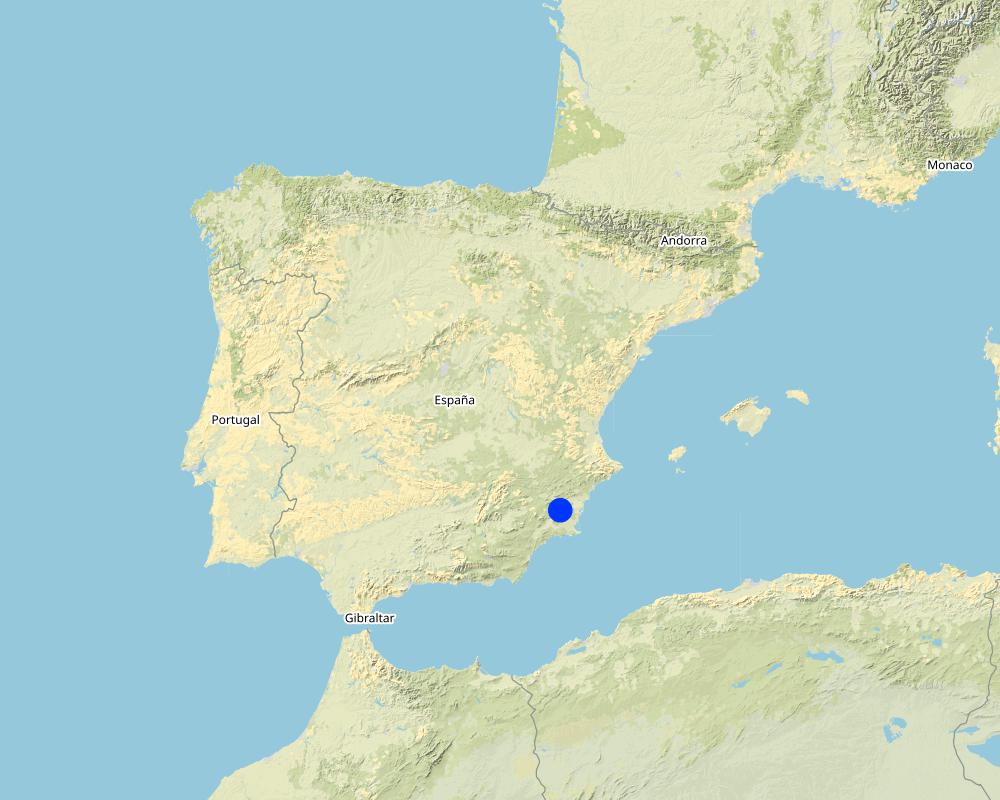Organic agriculture in the cooperative orchards of Murcia University [Spain]
- Creation:
- Update:
- Compiler: Alicia Morugán-Coronado
- Editor: –
- Reviewers: Mateo Jaimes, William Critchley
ECO-CAMPUS huerto sostenible
technologies_6415 - Spain
View sections
Expand all Collapse all1. General information
1.2 Contact details of resource persons and institutions involved in the assessment and documentation of the Technology
Key resource person(s)
SLM specialist:
Contreras Consuelo
Universidad de Murcia
Spain
1.3 Conditions regarding the use of data documented through WOCAT
The compiler and key resource person(s) accept the conditions regarding the use of data documented through WOCAT:
Yes
1.4 Declaration on sustainability of the described Technology
Is the Technology described here problematic with regard to land degradation, so that it cannot be declared a sustainable land management technology?
No
2. Description of the SLM Technology
2.1 Short description of the Technology
Definition of the Technology:
Allocation of organic rotation gardens for employees and people from the University of Murcia. It aims to demonstrate the viability of organic farming through a series of techniques and management practices in the cooperative orchards at the University of Murcia
2.2 Detailed description of the Technology
Description:
Annually, the University of Murcia allocates 28 agricultural plots to its employees and/or students for cultivation under organic farming. The plots are located on the Espinardo campus in Murcia (Spain). The plots, of approx. 20 m2, have an irrigation point connected to the general campus network. In the area where the garden plots are located, there is also storage space for community tools and other equipment for cultivating the land.
The most relevant objective that the university is pursuing is to demonstrate the viability of organic farming. This is through a series of practices (fertilization, pest control, crop associations, rotations) that solve specific agronomic problems. In order to develop these techniques and practices guidelines for these practices are given by the person responsible for the project. Some of the practices and techniques implemented are: exclusive use of non-polluting fertilizers, pest control by natural means, crop rotation, and the use of compost.
Each participant selects a vegetable variety to establish their own crop, mainly tomatoes (Solanum lycopersicum), lettuce (Lactuca sativa), beans (Phaseolus vulgaris), zucchini (Cucurbita pepo), spinach (Spinacia oleracea), radishes (Raphanus sativus), potatoes (Solanum tuberosum) and others. The fertilization is based on a non-contaminating fertilizer, mainly horse and goat manure from the Veterinary Faculty of the same university, in addition, a worm-based compost (vermiculture) provided by the university is applied annually. Additionally, pest control is carried out through adhesive strip traps, the addition of eggshells to the top soil against snails, and aromatic plants are cultivated on the border of the orchards to attract natural predators of pests. Additionally, organic waste from the management of the gardens is deposited in a composter installed nearby.
Furthermore, the ecological gardens are a meeting place, a relaxing yet productive area, where human relationships among the members of the university community are strengthened.
Finally, in order to promote gender empowerment, women are the main users and managers of the gardens; men’s presence is minimal – just occasionally to help with harvesting tasks.
2.3 Photos of the Technology
2.5 Country/ region/ locations where the Technology has been applied and which are covered by this assessment
Country:
Spain
Region/ State/ Province:
Murcia
Further specification of location:
Espinardo-Murcia
Specify the spread of the Technology:
- evenly spread over an area
If precise area is not known, indicate approximate area covered:
- < 0.1 km2 (10 ha)
Is/are the technology site(s) located in a permanently protected area?
No
Comments:
Universidad Murcia Campus Espinardo Eco-Campus
Map
×2.6 Date of implementation
Indicate year of implementation:
2014
If precise year is not known, indicate approximate date:
- less than 10 years ago (recently)
2.7 Introduction of the Technology
Specify how the Technology was introduced:
- through projects/ external interventions
3. Classification of the SLM Technology
3.1 Main purpose(s) of the Technology
- improve production
- reduce, prevent, restore land degradation
- preserve/ improve biodiversity
- create beneficial social impact
3.2 Current land use type(s) where the Technology is applied
Land use mixed within the same land unit:
No

Cropland
- Annual cropping
Annual cropping - Specify crops:
- vegetables - other
Number of growing seasons per year:
- 2
Specify:
Verano/Invierno
Is intercropping practiced?
No
Is crop rotation practiced?
Yes
If yes, specify:
winter and summer
3.3 Has land use changed due to the implementation of the Technology?
Has land use changed due to the implementation of the Technology?
- No (Continue with question 3.4)
3.4 Water supply
Water supply for the land on which the Technology is applied:
- full irrigation
3.5 SLM group to which the Technology belongs
- rotational systems (crop rotation, fallows, shifting cultivation)
- minimal soil disturbance
- integrated pest and disease management (incl. organic agriculture)
3.6 SLM measures comprising the Technology

agronomic measures
- A1: Vegetation/ soil cover
- A2: Organic matter/ soil fertility
- A5: Seed management, improved varieties
- A6: Residue management
A6: Specify residue management:
A 6.3: collected

management measures
- M6: Waste management (recycling, re-use or reduce)
3.7 Main types of land degradation addressed by the Technology

chemical soil deterioration
- Cn: fertility decline and reduced organic matter content (not caused by erosion)
- Cs: salinization/ alkalinization

physical soil deterioration
- Pc: compaction
3.8 Prevention, reduction, or restoration of land degradation
Specify the goal of the Technology with regard to land degradation:
- prevent land degradation
- reduce land degradation
4. Technical specifications, implementation activities, inputs, and costs
4.1 Technical drawing of the Technology
Technical specifications (related to technical drawing):
28 parcelas de 20 metros cuadrados cada una (5x4m) con punto de riego individual, establecido a lo largo de todas las parcelas procedente de una toma de agua corriente y con una caseta de utensilios agrícolas y compostadora para todos. Cada parcela tiene su marco de plantación en particular según la especie elegida para la época del año, se realizan 2 ciclos vegetativos, de invierno y verano. Las parcelas tienen unos 80 cm de separación entre sí y no hay pendiente en la parcela.
Author:
Alicia Morugán-Coronado
Date:
15/03/2022
4.2 General information regarding the calculation of inputs and costs
Specify how costs and inputs were calculated:
- per Technology area
Indicate size and area unit:
20m2
other/ national currency (specify):
euro
If relevant, indicate exchange rate from USD to local currency (e.g. 1 USD = 79.9 Brazilian Real): 1 USD =:
0.99
4.3 Establishment activities
| Activity | Timing (season) | |
|---|---|---|
| 1. | Soil preparation | october |
| 2. | Water irrigation | winter |
| 3. | Manure application | winter |
| 4. | Seed plantation | winter or spring |
4.4 Costs and inputs needed for establishment
| Specify input | Unit | Quantity | Costs per Unit | Total costs per input | % of costs borne by land users | |
|---|---|---|---|---|---|---|
| Labour | Soil preparation | 1 | 1.0 | |||
| Labour | Manure application | 1 | 1.0 | |||
| Labour | Water irrigation | 1 | 1.0 | |||
| Labour | Seed plantation | 1 | 1.0 | 100.0 | ||
| Equipment | Hoe | 1 | 1.0 | |||
| Equipment | Water hose | 1 | 1.0 | |||
| Equipment | Shed | 1 | 1.0 | |||
| Plant material | Seed | 1 | 25.0 | 1.0 | 25.0 | 100.0 |
| Plant material | Plants | 1 | 25.0 | 1.0 | 25.0 | 100.0 |
| Fertilizers and biocides | Horse Manure | 1 | 50.0 | |||
| Total costs for establishment of the Technology | 50.0 | |||||
| Total costs for establishment of the Technology in USD | 50.51 | |||||
If you are unable to break down the costs in the table above, give an estimation of the total costs of establishing the Technology:
60.0
If land user bore less than 100% of costs, indicate who covered the remaining costs:
University of Murcia covered the cost of stablishment activities
Comments:
Only the user bought the seed or plants
4.5 Maintenance/ recurrent activities
| Activity | Timing/ frequency | |
|---|---|---|
| 1. | weeding | 3 times per year |
| 2. | prunning | 2 times per year |
| 3. | harvesting | 2 time per year |
4.6 Costs and inputs needed for maintenance/ recurrent activities (per year)
| Specify input | Unit | Quantity | Costs per Unit | Total costs per input | % of costs borne by land users | |
|---|---|---|---|---|---|---|
| Labour | weeding | 1 | ||||
| Labour | prunning | 1 | ||||
| Labour | harvesting | 1 | ||||
| Equipment | hoe | |||||
| Equipment | scissors | |||||
| Equipment | boxes | |||||
| Fertilizers and biocides | pest control adhesive | 10 | 5.0 | 10.0 | 50.0 | |
| Total costs for maintenance of the Technology | 50.0 | |||||
| Total costs for maintenance of the Technology in USD | 50.51 | |||||
If you are unable to break down the costs in the table above, give an estimation of the total costs of maintaining the Technology:
50.0
If land user bore less than 100% of costs, indicate who covered the remaining costs:
University of Murcia
Comments:
The user only bought the pest traps
4.7 Most important factors affecting the costs
Describe the most determinate factors affecting the costs:
Only the users bought the material plant and the selected pest control that they choose in their individual plot
5. Natural and human environment
5.1 Climate
Annual rainfall
- < 250 mm
- 251-500 mm
- 501-750 mm
- 751-1,000 mm
- 1,001-1,500 mm
- 1,501-2,000 mm
- 2,001-3,000 mm
- 3,001-4,000 mm
- > 4,000 mm
Specify average annual rainfall (if known), in mm:
312.00
Specifications/ comments on rainfall:
Murcia has dry periods in April, May, June, July and August.
On average, October is the wettest month with 1.5 inch (39 mm) of precipitation.
On average, July is the driest month with 0.1 inch (3 mm) of precipitation.
Indicate the name of the reference meteorological station considered:
https://estacion.um.es/estacion/servlet/estacion.EstacionInit
Agro-climatic zone
- semi-arid
La temporada calurosa dura 3,0 meses, del 16 de junio al 14 de septiembre, y la temperatura máxima promedio diaria es más de 30 °C. El mes más cálido del año en Murcia es agosto, con una temperatura máxima promedio de 33 °C y mínima de 21 °C.
La temporada fresca dura 3,9 meses, del 17 de noviembre al 14 de marzo, y la temperatura máxima promedio diaria es menos de 20 °C. El mes más frío del año en Murcia es enero, con una temperatura mínima promedio de 4 °C y máxima de 17 °C.
5.2 Topography
Slopes on average:
- flat (0-2%)
- gentle (3-5%)
- moderate (6-10%)
- rolling (11-15%)
- hilly (16-30%)
- steep (31-60%)
- very steep (>60%)
Landforms:
- plateau/plains
- ridges
- mountain slopes
- hill slopes
- footslopes
- valley floors
Altitudinal zone:
- 0-100 m a.s.l.
- 101-500 m a.s.l.
- 501-1,000 m a.s.l.
- 1,001-1,500 m a.s.l.
- 1,501-2,000 m a.s.l.
- 2,001-2,500 m a.s.l.
- 2,501-3,000 m a.s.l.
- 3,001-4,000 m a.s.l.
- > 4,000 m a.s.l.
Indicate if the Technology is specifically applied in:
- not relevant
5.3 Soils
Soil depth on average:
- very shallow (0-20 cm)
- shallow (21-50 cm)
- moderately deep (51-80 cm)
- deep (81-120 cm)
- very deep (> 120 cm)
Soil texture (topsoil):
- medium (loamy, silty)
Soil texture (> 20 cm below surface):
- fine/ heavy (clay)
Topsoil organic matter:
- low (<1%)
5.4 Water availability and quality
Ground water table:
< 5 m
Availability of surface water:
medium
Water quality (untreated):
good drinking water
Water quality refers to:
both ground and surface water
Is water salinity a problem?
No
Is flooding of the area occurring?
Yes
Regularity:
episodically
5.5 Biodiversity
Species diversity:
- medium
Habitat diversity:
- medium
5.6 Characteristics of land users applying the Technology
Sedentary or nomadic:
- Sedentary
Market orientation of production system:
- subsistence (self-supply)
Off-farm income:
- > 50% of all income
Relative level of wealth:
- average
Individuals or groups:
- groups/ community
Level of mechanization:
- manual work
Gender:
- women
Age of land users:
- middle-aged
Indicate other relevant characteristics of the land users:
Las mujeres son las usuarias y las responsables de los huertos, la presencia masculina es pequeña o inexistente, solo para ayudar puntualmente en labores de cosecha, etc.
5.7 Average area of land used by land users applying the Technology
- < 0.5 ha
- 0.5-1 ha
- 1-2 ha
- 2-5 ha
- 5-15 ha
- 15-50 ha
- 50-100 ha
- 100-500 ha
- 500-1,000 ha
- 1,000-10,000 ha
- > 10,000 ha
Is this considered small-, medium- or large-scale (referring to local context)?
- small-scale
5.8 Land ownership, land use rights, and water use rights
Land ownership:
- company
Land use rights:
- leased
Water use rights:
- open access (unorganized)
Are land use rights based on a traditional legal system?
Yes
Specify:
Cesión anual por parte de la Universidad de Murcia
5.9 Access to services and infrastructure
health:
- poor
- moderate
- good
education:
- poor
- moderate
- good
technical assistance:
- poor
- moderate
- good
employment (e.g. off-farm):
- poor
- moderate
- good
markets:
- poor
- moderate
- good
energy:
- poor
- moderate
- good
roads and transport:
- poor
- moderate
- good
drinking water and sanitation:
- poor
- moderate
- good
financial services:
- poor
- moderate
- good
6. Impacts and concluding statements
6.1 On-site impacts the Technology has shown
Socio-economic impacts
Production
crop production
Comments/ specify:
Tras el uso del huerto ecológico cedido por la Universidad de Murcia, la usuaria pudo obtener varias cosechas de procedentes de sus rotaciones anuales.
crop quality
Comments/ specify:
Tras la aplicación de mejoras continuas en el huerto ecológico, la usuaria observó una mejora en la calidad de las especies cosechadas, mayor tamaño o mejor sabor
Water availability and quality
drinking water availability
Income and costs
expenses on agricultural inputs
Comments/ specify:
Ya que los gastos son responsabilidad de la Universidad de Murcia, la persona usuaria del huerto ecológico disminuyó sus gastos agrícolas, al no tener que pagar por la fertilización (compost y abono) y control de plagas (tiras adhesivas, etc)
Socio-cultural impacts
food security/ self-sufficiency
Comments/ specify:
Al poder consumir lo cultivado, la persona usuaria del huerto ecológico pudo consumir su propias variedades vegetales a lo largo del año.
health situation
Comments/ specify:
Al controlar lo que come, la persona usuaria del huerto ecológico pudo asegurar la ausencia de pesticidas o fungicidas en su alimentación, así como evitar la aplicación de fertilizantes contaminantes.
recreational opportunities
Comments/ specify:
Poder cultivar y hacer uso de las instalaciones cedidas por la Universidad de Murcia, supuso la oportunidad de pasar tiempo en contacto con la naturaleza, el suelo y otras personas usuarias, con las que intercambiar experiencias y conocimientos.
SLM/ land degradation knowledge
Comments/ specify:
La persona usuaria a lo largo del periodo de cesión del huerto ecológico pudo aprender y formarse en cuanto a la degradación y calidad del suelo, y realizar medidas correctoras gracias al asesoramiento externo o a recibir cursos especializados.
Ecological impacts
Soil
soil moisture
Comments/ specify:
Al aplicar un cultivo de cobertura vegetal anual, la humedad del suelo se ve favorecida bajo una capa de abono y especies vegetales continua.
soil cover
Comments/ specify:
Al plantar un cultivo de rotación el suelo se encuentra protegido de forma permanente durante todo el año
nutrient cycling/ recharge
Comments/ specify:
Tras el uso de abono o estiércol de caballo o cabra, y la aplicación de humus de lombriz, la recarga de nutrientes queda asegurada a lo largo del año
soil organic matter/ below ground C
Comments/ specify:
Tras el uso de abono o estiércol de caballo o cabra, y la aplicación de humus de lombriz, la materia orgánica del suelo se vio incrementada
Biodiversity: vegetation, animals
Vegetation cover
Comments/ specify:
Al aplicar un cultivo de cobertura vegetal anual, la humedad del suelo se ve favorecida bajo una capa de abono y especies vegetales continua.
beneficial species
Comments/ specify:
El control de plagas mediante diversificación de especies en la rotación anual, y la plantación de especies aromáticas en los bordes de las parcelas, incrementó la presencia de especies benéficas, como polinizadores y otros insectos de control biológico.
pest/ disease control
Comments/ specify:
Al no usar pesticidas o fungicidas y al llevar a cabo un control de plagas según lo establecido en un huerto típico de agricultura ecológica, mediante tiras adhesivas, cáscara de huevo molida contra caracoles y babosas, y se mantiene un seto al borde de la parcela de aromáticas con tal de atraer depredadores naturales de las plagas principales,
6.2 Off-site impacts the Technology has shown
impact of greenhouse gases
Comments/ specify:
Al mantener una cobertura vegetal anual se asegura la disminución de los gases de efecto invernadero mediante un sumidero natural de CO2 por parte de las especies vegetales plantadas en el huerto
6.3 Exposure and sensitivity of the Technology to gradual climate change and climate-related extremes/ disasters (as perceived by land users)
Gradual climate change
Gradual climate change
| Season | increase or decrease | How does the Technology cope with it? | |
|---|---|---|---|
| annual temperature | increase | moderately | |
| annual rainfall | increase | well |
Climate-related extremes (disasters)
Biological disasters
| How does the Technology cope with it? | |
|---|---|
| insect/ worm infestation | well |
6.4 Cost-benefit analysis
How do the benefits compare with the establishment costs (from land users’ perspective)?
Short-term returns:
slightly positive
Long-term returns:
slightly positive
How do the benefits compare with the maintenance/ recurrent costs (from land users' perspective)?
Short-term returns:
slightly positive
Long-term returns:
slightly positive
6.5 Adoption of the Technology
- single cases/ experimental
Of all those who have adopted the Technology, how many did so spontaneously, i.e. without receiving any material incentives/ payments?
- 0-10%
6.6 Adaptation
Has the Technology been modified recently to adapt to changing conditions?
No
6.7 Strengths/ advantages/ opportunities of the Technology
| Strengths/ advantages/ opportunities in the land user’s view |
|---|
| Cultivo propio libre de pesticidas |
| Comida saludable |
| Ahorro en verduras en mercados convencionales |
| Comer lo cultivado |
| Strengths/ advantages/ opportunities in the compiler’s or other key resource person’s view |
|---|
| Mejora a largo plazo de la calidad del suelo, estructura y mejora de compactación |
| Aumento de la materia orgánica en el suelo |
| Fijación de CO2 y gases de efecto invernadero por cultivo |
| Aumento de la biodiversidad y de la fauna útil contra plagas |
6.8 Weaknesses/ disadvantages/ risks of the Technology and ways of overcoming them
| Weaknesses/ disadvantages/ risks in the land user’s view | How can they be overcome? |
|---|---|
| Número de horas | Dedicarle tiempo los fines de semana |
| Control de plagas | Informarse y probar nuevos métodos |
| Retirada manual de malas hierbas | Disponer de un utensilio para eliminarlas |
| Dolores de espalda al trabajar agachada | Pedir ayuda en labores costosas |
| Weaknesses/ disadvantages/ risks in the compiler’s or other key resource person’s view | How can they be overcome? |
|---|---|
| Inversión inicial alta en plantones | Sobreponerse con el ahorro tras cosecha |
| Desconocimiento de asociación de cultivos | Recibir curso de diversificación de cultivos y rotaciones |
| Poca formación para control de plagas | Diseñar setos o bordes de parcela con plantas aromáticas y hoteles de insectos |
| Poca conciliación entre trabajo y horas dedicadas al cultivo | Favorecer la conciliación |
7. References and links
7.1 Methods/ sources of information
- field visits, field surveys
https://www.um.es/web/campussostenible/inicio
- interviews with land users
When were the data compiled (in the field)?
15/03/2022
7.2 References to available publications
Title, author, year, ISBN:
GUÍA DE HUERTOS ECOLÓGICOS. Los huertos eco-campus de la Universidad de Murcia; ISBN: 978-84-8371-949-7
Available from where? Costs?
https://guadanatura.es/producto/guia-de-huertos-ecologicos-los-huertos-eco-campus-de-la-universidad-de-murcia/
7.3 Links to relevant online information
Title/ description:
Web del huerto universitario
URL:
https://www.um.es/web/campussostenible/inicio
7.4 General comments
Las usuarias van rotando el cultivo 2 veces al año, y cada 2 años cambia la cesión del huerto a usuarias diferentes, de esta manera la Universidad de Murcia se asegura que el suelo tiene una renovación de nutrientes continuo.
Links and modules
Expand all Collapse allLinks
No links
Modules
No modules






